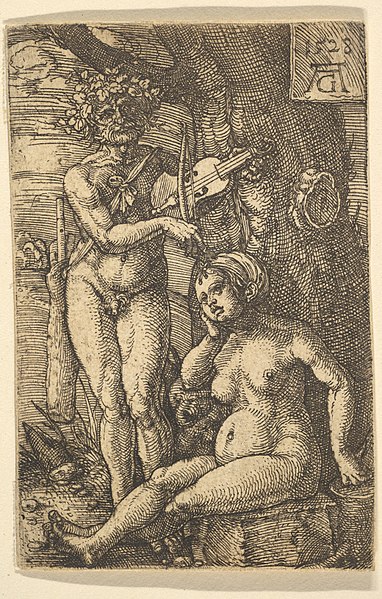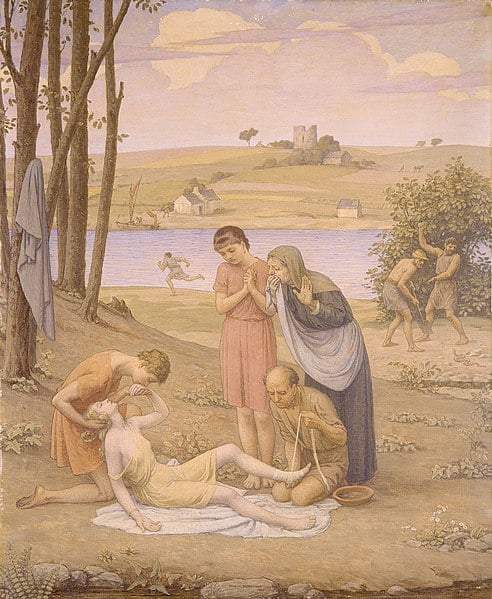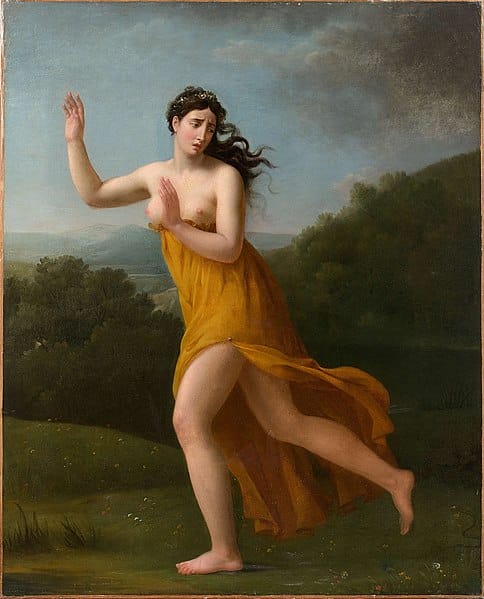The world of Greek mythology is vast, intricate, and filled with tales of love, betrayal, and heroism. Among these tales, the story of Eurydice stands out as a great reminder of the lengths one might go for love.
While Eurydice was never known as Riddy, as some more modern stories would have you believe, her story is still captivating, even now. Read on to get to know the real Eurydice. Maybe also learn how the original stands up to the more modern, yet quite cool version in the hit series Kaos.
Eurydice Key Facts
| Parents | Unknown |
| Partners | Orpheus |
| Siblings | The Auloniad Nymphs |
| Offspring | None |
| Other names | None |
| Roman name | Euridice |
| Best Known Myth | Orpheus’ descent into the Underworld |
Name and Etymology
Eurydice, a name that resonates with melancholy and love, has its roots in ancient Greek. The name itself can be broken down into “eurys,” meaning “wide,” and “dike,” which translates to “justice.” Thus, Eurydice might be interpreted as “wide justice.” In Roman tales, she is known as Euridice. Throughout various myths, she doesn’t have many epithets, primarily because her story is so intertwined with that of Orpheus, her lover.
The tale of Eurydice and Orpheus is one that has been told and retold, with each iteration emphasizing the depth of their love and the tragedy that befalls them. The Roman adaptation of the story retains much of its original essence, showcasing the universality of their tale.
While Eurydice herself might not have many other names, her story’s impact is undeniable. The weight of her name carries the sorrow and love of a tale that has transcended time, reminding us of the impermanence of life and the enduring nature of love.

Eurydice’s Family and Relationships
Eurydice, with her ethereal beauty and tragic tale, is not just a mere mortal in Greek mythology but an Auloniad nymph. The Auloniads are nymphs of the pastures and glens, often found in mountainous regions. As spirits of nature, they were believed to inhabit the landscapes, bringing life and vitality to the meadows and valleys they presided over. Their connection to the natural world made them revered figures in Greek mythology.
Eurydice’s origins, while rooted in her identity as an Auloniad nymph, remain somewhat shrouded in mystery. Unlike many figures in Greek mythology, her parentage isn’t explicitly mentioned in most texts. This obscurity adds to the ethereal and tragic nature of her tale.
Her life was relatively uneventful until she crossed paths with Orpheus, the legendary musician. Their love story is one for the ages; they fell deeply in love and were inseparable. However, as with many tales from this era, their happiness was short-lived. On their wedding day, Eurydice was bitten by a snake and succumbed to its venom, plunging Orpheus into profound grief.
Myths about Eurydice
Eurydice, a figure of ethereal beauty and grace, has been a muse for poets and artists, as well as storytellers throughout the ages. Her tale mixes both love, tragedy, and the lengths one might go to reclaim a lost love.
The Tragic Death of Eurydice
Eurydice was the beloved wife of the talented musician Orpheus. Their love was the stuff of legends, a bond so strong that even the gods took notice. On their wedding day, Orpheus played jubilant melodies as Eurydice danced joyfully through the meadows. However, fate had a different plan. One fateful day, as Eurydice was being pursued by Aristaeus, she stepped on a viper. The venomous bite was swift, and Eurydice succumbed to its deadly poison, leaving Orpheus heartbroken.
Distraught and inconsolable, Orpheus’ mournful melodies resonated with such sorrow that even the nymphs and deities wept. They advised him to journey to the Underworld and attempt to retrieve his beloved Eurydice. With hope in his heart and his lyre in hand, Orpheus embarked on this perilous quest.

Orpheus’ Descent into the Underworld
Orpheus’ journey to the Underworld was fraught with challenges. However, his enchanting music had the power to soften even the hardest of hearts. His melodies were so poignant that they made the very stones weep and persuaded the guardians of the Underworld to allow him a chance to reclaim Eurydice. In some tales, it’s said that Orpheus played his lyre to lull Cerberus, the three-headed guardian of Hades, into a deep slumber, allowing him passage.
However, there was a condition attached to Eurydice’s release: Orpheus must lead her back to the world of the living without looking back at her until they had both crossed the threshold to the upper world. As they neared the exit, doubt plagued Orpheus’ mind. Fearing he had been deceived, he turned to gaze upon Eurydice. Tragically, she hadn’t yet crossed the threshold and was immediately pulled back into the Underworld, lost to Orpheus forever.
Variations of the Myth
The tale of Orpheus and Eurydice has seen many interpretations and variations over time. For instance, Virgil introduced the tragic outcome where Orpheus, overwhelmed by doubt, looks back at Eurydice. In contrast, Plato’s representation in his “Symposium” paints Orpheus in a less flattering light. Plato suggests that the gods only presented an apparition of Eurydice to Orpheus, mocking him for not being willing to die for his love. As a result, he was punished by being given only a glimpse of his wife in the Underworld and later met a tragic end at the hands of the Maenads.
Interestingly, the story of Eurydice might be a later addition to the Orpheus myths. Some suggest that the name Eurydice, meaning ‘she whose justice extends widely’, might be linked to Persephone, the queen of the Underworld. This connection hints at a possible derivation from another Orpheus legend where he charms Persephone with his music.
The tale of Eurydice and Orpheus has parallels in various cultures, from the Japanese myth of Izanagi and Izanami to the Mayan myth of Itzamna and Ix-chel. Such universal themes of love, loss, and the afterlife resonate deeply across different civilizations and eras.
Depiction And Characteristics
Eurydice is often depicted as a young, ethereal woman, representing the fleeting nature of life. Her beauty moreover is said to have been unparalleled. Both capturing the heart of Orpheus and leaving an indelible mark on mythology.
Symbols associated with Eurydice are often intertwined with those of Orpheus. The lyre, representing Orpheus’ musical talents and his attempt to retrieve her from the Underworld, is a common symbol. Snakes, representing her untimely death, are also frequently associated with her.
In terms of personality, Eurydice is often portrayed as gentle, loving, and somewhat elusive. Her tragic end amplifies these characteristics, painting her as a figure of innocence lost too soon.
Animals or plants aren’t directly associated with Eurydice. However, the cypress tree, often linked with the Underworld and mourning, could be seen as a symbol of her tragic tale.

Representations Of Eurydice In Art
Eurydice’s tragic tale has inspired countless artists throughout history. Her story, intertwined with Orpheus’, has been depicted in various mediums, from ancient pottery to Renaissance paintings.
One of the most famous depictions is Rodin’s sculpture, “Orpheus and Eurydice.” This masterpiece captures the agonizing moment when Orpheus loses her for the second time, emphasizing the raw emotion and despair of the moment.
Another notable representation is the painting “Orpheus Leading Eurydice from the Underworld” by Jean-Baptiste-Camille Corot. The artwork beautifully captures the fleeting moment of hope before the tragic end, with Eurydice following Orpheus in a dreamlike state.

Mentions of Eurydice in Ancient Texts
Eurydice’s tragic tale has been immortalized in various ancient texts, each offering a unique perspective on her story and the undying love between her and Orpheus. Let’s delve into some of the most notable mentions:
Virgil’s “Georgica”
Written around 29 BC, Virgil’s “Georgica” is a poem dedicated to the theme of agriculture. Virgil, a prominent ancient Roman poet, is best known for his epic, the “Aeneid.” In “Georgica,” he introduces the tragic outcome of Orpheus looking back at Eurydice just before they reach the surface.
Quote: “So runs the tale: Eurydice, in flight from Aristaeus, met her doom and sank back to the Stygian wave.”
Plato’s “Symposium”
Penned in approximately 385-370 BC, Plato’s “Symposium” is a philosophical text that explores the nature of love. Plato, a foundational figure in Western philosophy, often used dialogues to convey his ideas. In “Symposium,” however, he presents a more cynical view of Orpheus’s journey to the Underworld.
Quote: “The infernal deities only presented an apparition of Eurydice to him.”
Ovid’s “Metamorphoses”
Written in 8 AD, “Metamorphoses” is a narrative poem by the Roman poet Ovid, who is known for his love poems and mythological narratives. In this work, he retells the story of Orpheus and Eurydice, emphasizing the heart-wrenching moment Orpheus loses her for the second time.
Quote: “Eurydice, dying now a second time, uttered no complaint against her husband. What was there to complain of, but that she had been loved?”
Frequently Asked Questions
Eurydice tragically died after being bitten by a snake on her wedding day to Orpheus.
While Orpheus charmed Hades and Persephone with his music to release Eurydice, he tragically looked back at her before reaching the surface, causing her to be pulled back into the Underworld forever.
Eurydice’s tale is sometimes paralleled with figures like Briseis in the context of the Trojan War, highlighting the roles of women in larger narratives.
Eurydice is often associated with the lyre (due to Orpheus) and snakes, which caused her untimely death.
In Roman tales, Eurydice is known as Euridice, and while the core essence of the story remains, there are subtle variations in the narrative.
Artists like Rodin and Jean-Baptiste-Camille Corot have created masterpieces inspired by the tragic love story of Eurydice and Orpheus.
Featured Image Credit: Antoinette Béfort, Public domain, via Wikimedia Commons

